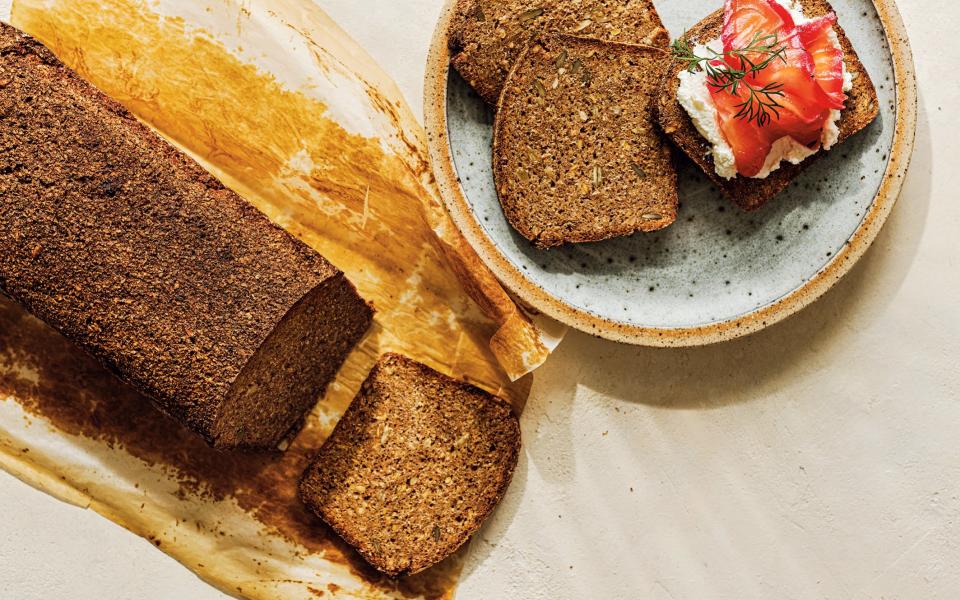How to bake the perfect rye bread loaf

It was the rye bread rolls I had at Dill, a much-celebrated restaurant in Reykjavik, that really made me fall in love with rye bread. These rolls – large brown pebbles – looked as if they’d been foraged or picked up from the seashore rather than made by human hands. They were served with cultured butter speckled with dill.
I’ve never eaten tree bark – though it has been ground and mixed with wheat flour when wheat flour was scarce – but if it was palatable this is what it would taste like. Woodiness wasn’t this bread’s only quality, it also had an edge of sourness balanced by sweetness, from molasses or dark-brown sugar. The dill butter brought notes of pine. An extraordinary meal followed, but not a single course has stayed with me the way those rolls have.
On another trip to Iceland – it’s a country I keep returning to – I watched the chef from a hotel kitchen put sweet rye loaves in a warm geothermal pit at dusk, so they would be ready for breakfast.
Rye bread is mostly baked in cool northern and eastern European countries, though you find it in France and Spain as well. There are even rye breads in northern Portugal and the areas of Italy that border Switzerland and Austria.
They’re all different. Russian and Baltic rye breads are dark, intense, almost chocolatey; in Sweden, Finland and Iceland they tend to be sweeter, and robust loaves are more common in Denmark and northern Germany. Danish rugbrød is sturdy enough to act as a plate for smørrebrød (an open sandwich), but it’s never just a plate. Its solidness means that it doesn’t fall apart as the juices from the topping leach into it (though the layer of butter helps to keep bread and topping apart), and its flavour can take the foods – cured herring, smoked salmon, peppery radishes – that are so popular in Scandinavia.
In the past I’ve moaned about looking after sourdough starters, a culture of flour and water. I would forget to feed them. (You need to get rid of half the starter every day and ‘refresh’ it with new flour and water. If you keep it in the fridge you only have to do this once a week.)
I’m lazy about kneading, too. You can knead your dough in a food mixer, but that seems like cheating. I’ve watched great sourdough bakers like Vanessa Kimbell knead as if their souls are in tune with the dough. The pushing and folding looks like waves lapping. My movements are tentative and abrupt. I haven’t made sourdough loaves often enough for the bread to become part of me.
But as most – though not all – rye breads are based on a sourdough starter I had to make it if I was going to eat rye breads. Luckily, those with a high rye content don’t require kneading, just mixing. Rye proteins have only a limited ability to form gluten (although many rye loaves contain a proportion of gluten-producing wheat flour as well).
Because rye doughs are stickier than wheat doughs, you will initially find making rye breads a bit frustrating. It’s also very easy to undercook them and end up with a ‘gummy’ texture. Make sure your oven gets to temperature.
If you like the end product you’ll weather these problems and keep trying. I still have to master Russian Borodinsky bread – flavoured with coriander, it even smells like Russia – and also proper German pumpernickel (it takes days to make). As with novels, there are too many to try and not enough time.
I’ve now become obsessed with my sourdough starters on this mad rye-bread-making journey. I keep them on the kitchen counter and feed them every day. The last thing I do at night is listen to them bubbling. It’s as soothing as listening to the sea inside a shell. ‘What will you become?’ I think.
Swedish limpa bread
This Scandinavian bread doesn’t require a rye sourdough starter. It contains rye flour but only a small amount. If you don’t have Scandinavian dark syrup – though you can get it online (scandikitchen.co.uk) – use golden syrup instead. The spices and the orange zest make this very distinctive and it’s quite sweet, too.

Baltic black bread
Dark, sweet and scented with caraway, this is a great bread and an easy one to make. I’ve also explained how to make a sourdough starter. It’s the same for all breads using a rye sourdough starter.

Danish rugbrød
Rye breads are made all over Scandinavia, but this is the best-known. It’s dense and full of seeds, and brilliant for making smørrebrød. Plus, unlike bread that is made with wheat, it also lasts really well.


